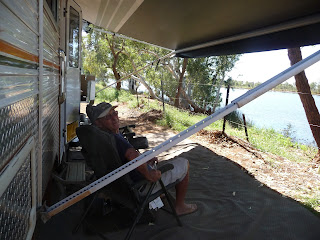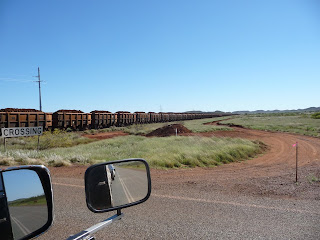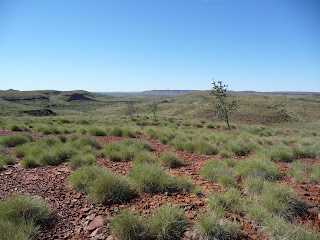26th July 2013
Hamersley Iron as it was known then (now
Rio Tinto) purchased Karratha Station and established the town of Karratha in
1968 to support its mining industry. The name Karratha is local language for
Good Country.
Karratha is a bustling town of about 18,000
permanent residents and a large fly in fly out worker population, FIFO’s as
they are known. It has a growing population with housing developments popping
up everywhere. House and land prices are at extortion levels and rents are
killers also, all related to the high earning capacity of the work force, which
means anybody unfortunate enough to be stationed there eg school teachers or
government workers, really do it tough. There is obviously plenty of money to
be made as every house you pass has a big boat or caravan parked in its
driveway (or both).
Although a large number of people live in
various company camps situated between Karratha and Dampier some 20 – 30kls
away the greater majority live in Karratha and I presume the camps cater mainly
for FIFO’s.
Iron ore from Rio’s mines at Tom Price,
Paraburdoo and Pannawonica is shipped out from massive loading facilities at
Parker Point Dampier. Mineral salt is also produced at Dampier like at Port
Hedland and is exported globally. Further out on the peninsula are the gas
production establishments for the North West Shelf Project involving several
companies such as BHP Billiton, BP Developments, Chevron Australia, Japan
Australia LNG (MIMI), Shell and Woodside Energy being the operator. The place
is colossal, you can see several flare stacks from quite a distance as you
drive towards the location but you can’t see much of the workings, as you come
over a rise in the road near the operation it is quite jaw dropping as a scene
like something out of starwars evolves in front of you, it is massive and when
you see it at night time it is just a blaze of lights.
According to a brochure I was given the gas
plant covers over 200 hectares and produces 12,000 tonnes od domestic gas per
day. 52,000 tonnes LNG per day. 4,200 tonnes LPG per day and 165,000 tonnes
barrels of condensate per day.
All the gas comes from several offshore
production platforms one of which also produces 30,000 barrels of oil per day
from several oil fields in the region.
We did a conducted tour of the town, salt
production and iron ore facilities and later drove back to check out the gas
production establishment - it was all quite mind blowing.
24th July - Stairway to the
moon, this is a phenomena that takes place when the full moon rises in a
direction that coincides with wet mud or sand flats (ie low tide). As the moon
rises above the horizon it casts a path of light across the wet sand or mud and
with the natural tidal depression across the flats it gives the impression of a
stairway, very intriguing. According to the visitor information booklet we had
obtained, this phenomena was to take place at 6:35pm and as we were in the
vicinity (gas production plant) at 4:00pm we reckoned we could kill a couple of
hours rather that travel back to our vans 30kls and then come all the way back.
Around 5:30pm son David phoned for a chat and said the moon was still visible
in Brisbane, by 6:30 pm it was almost standing room only on the beach with
vehicles of all sorts including motorhomes lined up facing the sea like something
out of a Mad Max weird invasion about to start. By 7:30pm apart from being
starved and busting for a pee the bloody moon still hadn’t arrived and there
was a general consensus of opinion that the brochure time was either wrong or
it was the wrong month. Eventually, God knows what time it was, a withering
cheer broke out along the bay as the moon finally poked its nose up over the
horizon and we all forgot about our bladders.
We stayed at the Balmoral Caravan Park it’s
well set out, big sites, nice wide roadways, good amenities and good water in
fact I was allowed to wash both the caravan and car a first for the van since
leaving Brisbane and didn’t it need it.
I had the Toyota serviced and mine wages
were reflected by the hole in my wallet. Karratha probably has every service
you can imagine but you can’t get a caravan or caravan fridge repaired.
So we are heading down to Exmouth where
supposedly there is someone who may be able to help with my van issues.
Following are some statistics that I noted
during out bus tour of Karratha and Dampier.
Karratha
established 1968 by Hamersley Iron
Currently
approximately 18,000 permanent residents
Water
supply comes from Harding River dam
Annual
rainfall is 255mm
Wet
season Nov – April
No
roof gutters on any houses, when it rains it buckets down.
Rents
are $1500 - $2200 per week (basic 1960/70’s homes).
Homes
$900,000 to purchase
Parker
Point ore terminal
24
ore trains per day
236
ore cars per train
112
tonnes per car
Trains
2.3 kls long
3
locos pull each train
takes
roughly 3 hrs to unload a train
Two
stockpile areas 13 x 210,000 tonnes and 13 x 200,000 tonnes
Shipping:
Ships
carry around 180,000 – 220,000 tonnes per trip
Ships
take around 24 – 36 hrs to load
Load
rate is about 10,000 tonnes per hour
Shipping
channel is 22kls long and dredged every 5-10 years
Ships
are computer loaded to give minimum clearance to channel bottom eg: 100mm
(4inches)
The
large airport caters for 700,000 people per annum mainly FIFO’s
Workforce
comprises approximately 6000 fulltime and 1000 contractors.
Salt
Production
Operating
area 10,000 hectares
Production
4.2 million tonnes per annum
Salt
is grown on crystals and harvested once a year
Harvesting
rate is 1,600 tonnes per hour
Average
evaporation of production area is 420,000 tonnes of water per day.
Amount
of salt deposited in crystallisers 270mm per year
Ships
loaded at 2,500 – 3,000 tonnes per hour
Salt
harvested is used mainly for chemicals, industrial use and road de-icing in
Europe.









































